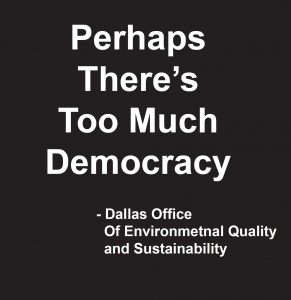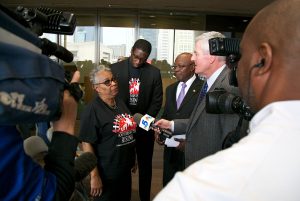Air quality monitoring
First Regional Air Monitoring Network “Meet and Greet” in Joppa Draws Packed House and Volunteers
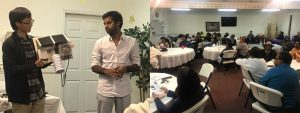
A new regional air quality network bringing 21st Century science to some of Dallas’ most polluted neighborhoods had it’s official coming out party on December 5th in the former Freedman’s community of Joppa.
A community meeting at New Zion Missionary Baptist Church sponsored by Downwinders at Risk in association with Paul Quinn College and Habitat for Humanity drew a standing room only crowd.
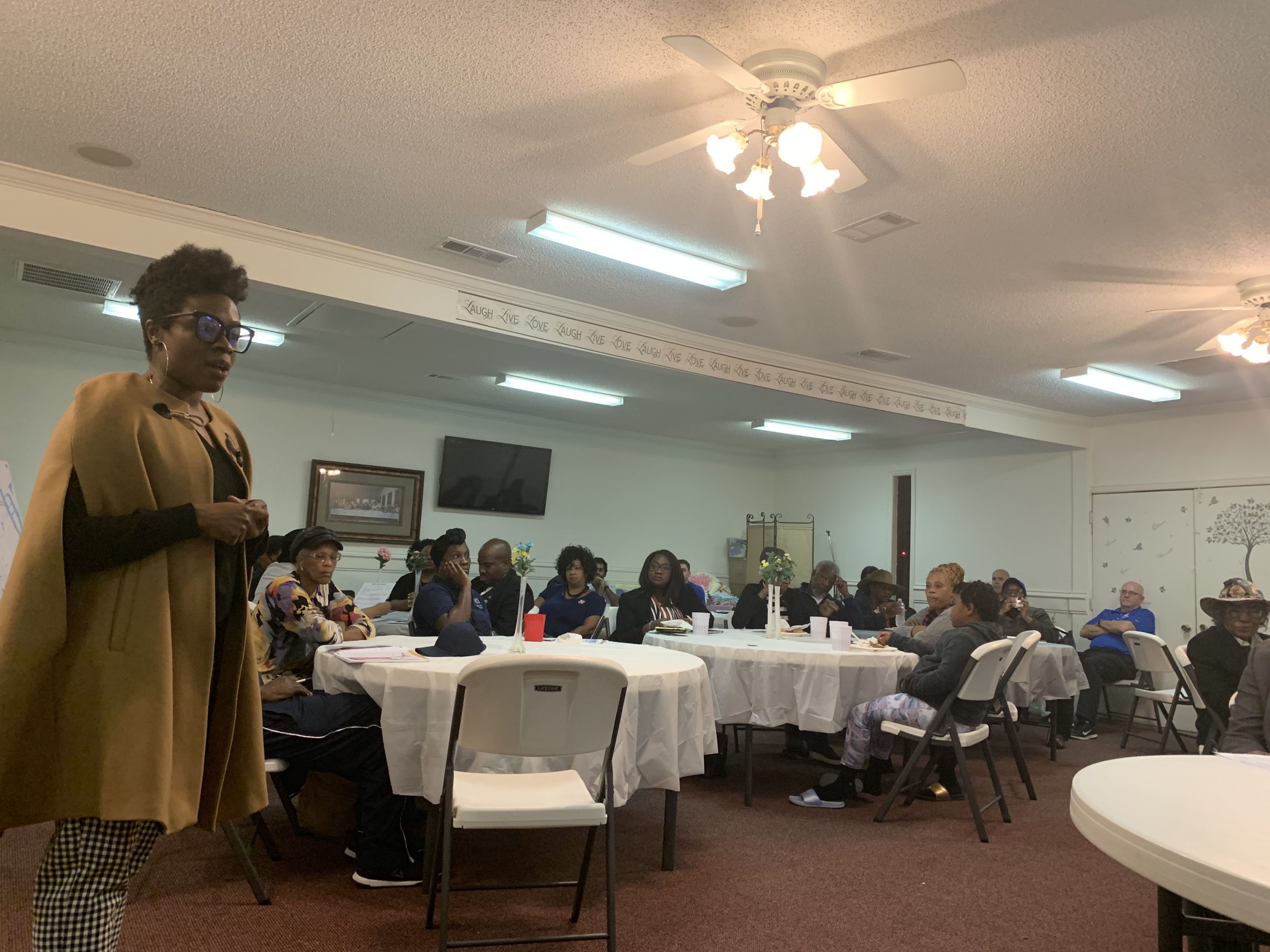 Food from Jason’s, door prizes, and the opportunity for a Parkland Hospital health screening made the meeting into a real community event.
Food from Jason’s, door prizes, and the opportunity for a Parkland Hospital health screening made the meeting into a real community event.
Residents got to see a monitor up close and hear a presentation by the University of Texas at Dallas graduate students building them for distribution over the next year. 11 of the monitors are due to be installed in Joppa, with another 11 installed in near-by Southern Dallas neighborhoods by Paul Quinn College. In total, over 100 are scheduled to be distributed from Plano to Fort Worth to Midlothian in the largest non-government network of its kind in Texas.
Joppa is surrounded by multiple sources of Particulate Matter air pollution, including a concrete batch plant, an asphalt batch plant, a Union Pacific railroad switch yard, Loop 12 and the Tamko asphalt shingle factory. Because of its compact size an relatively small population, it has the highest per capita air pollution burden in Dallas.
That’s why Downwinders chose to begin building its part of the network in Joppa. Thursday’s roll out was the first attempt to find hosts for the monitors among the neighborhood’s residents.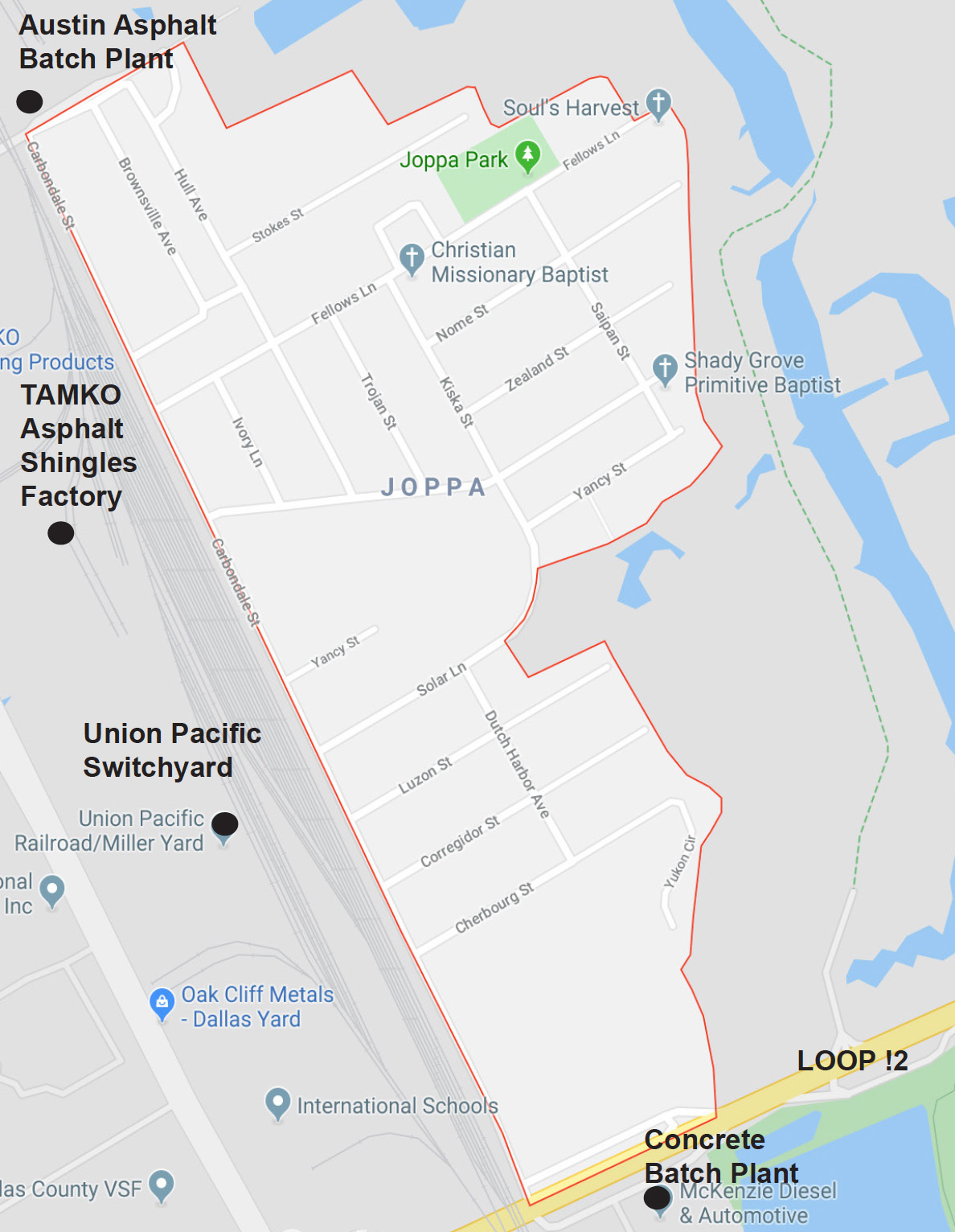
There were lots of questions and lots of enthusiasm. At least two Joppa residents didn’t need any more convincing and wanted to know how fast they could get a monitor at their house.
The answer is….soon. District 7 Council Member Adam Bazaldua is assisting the network in coordinating the electrical and internet connections we need for the “mothership” that carries the load for 10 smaller solar-powered and wireless sensors. A utility pole Downwinders bought from Oncor for that very purpose is only about 30 feet down the street road the New Zion Church where the meeting was taking place. All we need now are the connections.
Downwinders will be following up this meeting with door-to-door canvassing in Joppa and updates to everyone who signed-in. Meanwhile, we should be scheduling similar meetings in West Dallas and Midlothian after the first of the year.
After years of planning and preparation, we’re finally beginning to see the payoff of our vision. Thanks to all of our supporters for helping us achieve this first, but important milestone
“SharedAirDFW” is DFW’s New Regional Air Quality Monitoring Network
Monitors are being assembled.
Software is being written.
Community meetings are happening.
Downwinders is helping build the region’s
first 21st-Century Air Network
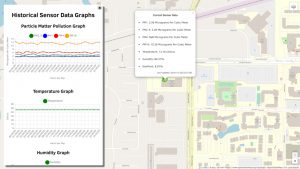
The first images from the mapping app UTD students are building for the new SharedAirDFW Air Quality Monitoring Network. Here data is being received by monitors already installed on the UTD campus. Residents will be able not only to see current conditions but levels over the last 24 hours or more.
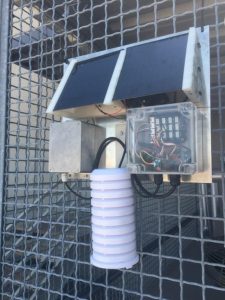
One of the over 100 new SharedAirDFW air quality monitors being built in the UTD laboratory that will be distributed throughout DFW, including Joppa, West Dallas, Southern Dallas, and Midlothian.
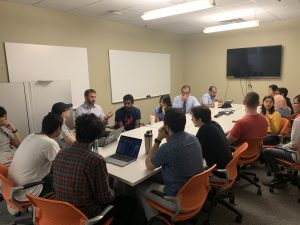
UTD students working with Downiwnders’ consultant Robert “the map” Mundinger on the SharedAirDFW mapping app software and interface.
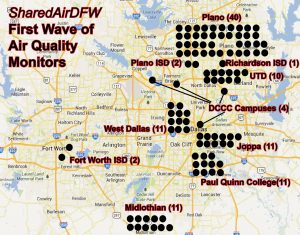
By this time next year the Network plans on having over its first 100 air quality monitors distributed throughout DFW, including the “front line” communities of Joppa, West Dallas, Southern Dallas and Midlothian.
____________________________________
Real Time Air Quality Information is Coming to DFW
It’s taken years of work and a lot of patience but with any luck a new citizen-friendly regional air monitoring network will debut in 2020.
Under the working title of “SharedAirDFW” over 100 new custom-built air quality monitors are being distributed throughout the DFW region in the next 12 months that will be able to give residents real time information about the air they breathe for the first time. When it’s up and running, it’ll be the first network of its kind in Texas and one of the largest in the U.S.
Based out of the University of Texas at Dallas laboratories and fueled by its graduate students, as well as Downwinders’ grant monies, these monitors will offer real time information through a easily accessible app.
Right now a handful of official EPA monitors provide air quality readings up to one or two hours behind real time conditions. SharedAirDFW willl increase the number of calibrated air quality monitors in DFW by a factor of four while giving readings updated every few seconds.
Almost half of the new monitors are going to front line communities in the DFW area: 33 monitors purchased by Downwinders are going to Joppa, West Dallas, and Midlothian, while another 11 purchased by Paul Quinn College are slated for the Southern Dallas neighborhoods surrounding its campus.
Joppa residents will get a preview of the system at a December 5th community roll out involving UT researchers, Habitat for Humanity, Paul Quinn, and local elected officials. Community events in Midlothian and West Dallas will follow.
This is one of the most important projects Downwiders has helped birth in its 25 year history. We’ll be bringing you updates as we get closer to bringing the whole system online. Thanks for you support.
Update: A 21st Century Regional Air Monitoring Network for DFW is On Its Way
 me technical and bureaucratic hitches, momentum is starting to build toward the 2020 operation of a true 21st Century DFW regional air quality monitoring network.
me technical and bureaucratic hitches, momentum is starting to build toward the 2020 operation of a true 21st Century DFW regional air quality monitoring network.
A small army of University of Texas at Dallas graduate students are assembling over 100 solar-powered wireless air monitoring units to be dispersed throughout the metro area. A third of those have been purchased by Downwinders for placement in Joppa, West Dallas, and Midlothian. 40 or more or going to Plano. Three Dallas County Community College campuses are receiving one, along with the Fort Worth and Richardson school districts.
And now news has come that Paul Quinn College has received an EPA grant to purchase 11 of these monitors for placement around its Southern Dallas campus. Downwinders is working to coordinate the location of its Joppa area monitors with Paul Quinn to provide Southern Dallas with its own mini-network of monitors.
Meanwhile another group of UTD students are working on the mapping software and app residents will be able to use to access the data in real time. They’re being led in this effort by Robert “The Map” Mundinger, who Downwinders hired for the job. All in all, Downwinders has now invested almost $50,000 in this network, which we hope will become a model for the rest of Texas and the nation.
Downwinders Wins Prestigious Ben and Jerry’s Foundation Grant to Help Build New DFW Air Quality Monitoring Network

Downwinders at Risk is excited to announce that we won a $20,000 Ben & Jerry’s Foundation grant to help add high-tech, low-cost air quality sensors to our growing community air network powered by the expertise and hardware of the University of Texas at Dallas.
While we applied in the past for these prestigious national grants, this is the first time we’ve received one. It’s kind of a big deal for us.
Our winning grant proposed combined old-fashioned community organizing with the installation and maintenance of new solar-powered, wifi-connected Particulate Matter monitors. Real time information from those monitors will be accessible through a free app you can download on your phone. This information can be used to propel a variety of public health and public policy initiatives.
Depending on how much of a bulk discount we can get, the grant should be able to buy at least 20-30 additional more monitors to add to the 11 we’ve already ordered. Our plan is have all of these up and operating by this time next year.
Dallas’ Joppa neighborhood will get the first wave of these. We’re already finding locations for them in the community. We’re beginning discussion with West Dallas community leaders to bring at least as many or more monitors to that abused part of town as well.
Residential communities adjacent to or directly downwind of major PM pollution sources are the first priority, but we hope to keep expanding to make the network as comprehensive as possible. There are plans to begin assembling a community air network board or committee of some type to oversee the Network. Stay tuned.
Dallas Staff Attempts COG Coup on Air Monitoring Network
After being rebuffed by its own city council on the idea, Dallas Staff Goes to NCTCOG to promote autocratic regional air monitoring network
You may remember that way back last September members of the Dallas City Council Quality of Life Committee approved a independent regional air network as laid out in a 20 minute presentation by the University of Texas at Dallas’s Dr. David Lary and Downwinders’s Director Jim Schermbeck. They approved it 7-0 with even Rickey Callahan voting for it.
Usually when things get voted that favorably out of a Committee, they head straight to the full Council and get approved. But moments after the Committee vote City Staff demanded it not be sent to the full Council until December.
Everyone who knew the backstory of how much the Dallas Office of Environmental Quality and (Rockefeller) Sustainability hated the idea of such a network knew what was really going on. And sure enough, here it is April and there’s still no movement on the one regional network idea officially endorsed by a City Council Committee.
But guess what? Staff isn’t just standing still. No, they’re on the move. They’re not only going out of their way to shoot down the air monitoring network approved by members of their own the city council; they’re going out of their way to ignore the Dallas City Council all together and take their case for a more autocratic, less public network to the North Central Texas Council of Governments, or “COG.”
Not satisfied with allowing the worst environmental justice crisis since West Dallas to explode into Shingle Mountain during his watch, OEQ&(R)S’s James McQuire is now out to make sure Dallas residents never get a chance to make decisions about monitoring air quality in their own backyard.
Why? Because as one Dallas staffer put it, “too much participation by the public can be a bad thing.” McQuire and Company want a monitoring network staff can control without citizen participation or accountability, in other words the Status Quo. But of course the status quo has failed spectacularly to address both the region’s old, and new air pollution problems. UTD and Downwinders are proposing a model with heavy doses of public participation and representation.
So last month, McQuire submitted a request to COG to ignore what his own Dallas city council committee had endorsed, and instead start from scratch to build a less-democratic, more staff-driven network that would be run by the same agency that for years denied the Midlothian cement plants had any impact on DFW air quality. He did this OVER THE OBJECTIONS of Quality of Life Chair Sandy Greyson, who has a healthy skepticism of CO’s abilities to look out for Dallas’ interests.
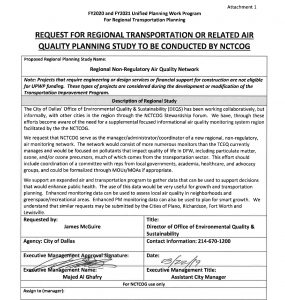 Like members of the Dallas Citizens Council who to make an end run around the City Council to get their own pet projects funded – see the VisitDallas headquarters slated for the new extension of Kyle Warren Park that is now being pimped by COG’s Director Michael Morris – McQuire is now circumventing his own Council and seeking relief from a “regional” agency that has historically only looked at air quality as an obstacle to highway funding.
Like members of the Dallas Citizens Council who to make an end run around the City Council to get their own pet projects funded – see the VisitDallas headquarters slated for the new extension of Kyle Warren Park that is now being pimped by COG’s Director Michael Morris – McQuire is now circumventing his own Council and seeking relief from a “regional” agency that has historically only looked at air quality as an obstacle to highway funding.
So let that soak in – Dallas city staff is intentionally ignoring its elected city council and the only air monitoring approach that council is on record as supporting, and instead now backing its own more autocratic version which has never been voted on by council and in fact was rejected out of hand by council members when asked.
It would take a novel’s worth of history to make the full case of why the COG is a poor choice for any new serious clean air effort in DFW but let’s start with just fundamentals.
COG has never cared about air quality from a public health perspective. Ever. Any work it’s done or is doing now – including promotion of electric vehicles and other anti-smog measures – are aimed at keeping DFW out of “non-attainment status” with the Clean Air Act in order to keep getting precious federal highway money. As long as the dollars keep flowing, COG isn’t interested in taking on other kinds of air pollution besides smog, or doing research into how even routine levels of combustion pollution are harmful, or until this moment, shown any interest in doing the air monitoring other metro areas are now routinely engaged in.
This skewed perspective is reflected in the language of McQuire’s proposal to COG. It’s all about how this air monitoring network could be a boon to transportation planning and oh by the way, maybe be of some public health interest too.
Because it lacks a public health perspective and is run by a cabal of local governments and staff by way of committees 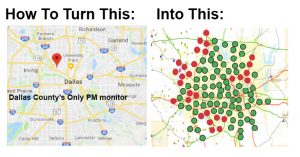 within committees, COG has been every bit as pro-active about bad air as the Dallas OEQ(R)S under McQuire, which is to say not a bit.
within committees, COG has been every bit as pro-active about bad air as the Dallas OEQ(R)S under McQuire, which is to say not a bit.
Downwinders spent years trying to convince COG leadership that three giant cement plants located in close proximity to each other in Midlothian, upwind of Dallas, and in eyesight of I-20 did in fact contribute to DFW smog. Despite spewing the equivalent of half a million cars worth of air pollution every year and being sited just across the Dallas and Tarrant county lines, the COG folks just didn’t get it – until Downwinders had to petition the EPA to bring those cement plants into DFW’s official smog plan itself. Those cement plants now have to be included in regional anti-smog plants but COG didn’t do that, citizens did.
When COG was writing its anti-smog plans, there were only two sides represented in it regional Clean Air Steering Committee: city staff and business. It took Downwinders to organize a collective boycott of this process until environmental groups were given seats at the table. COG didn’t do that, citizens did.
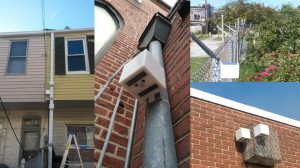 When fracking came to DFW, COG was as reluctant to point the finger at this huge source of new air pollution as it had been with the Midlothian cement plants. Why? Because local governments were benefactors of the Barnett Shale “boom” in tax revenues and drilling leases. COG steered clear from even acknowledging gas drilling as a significant air pollution problem and aligned with industry to dismiss concerns. It was up to local residents living next to drilling pads and compressor stations to write new rules for everything the drilling boom brought with it. Dallas residents wrote the most protective gas drilling rules in the state. COG didn’t do that, citizens did.
When fracking came to DFW, COG was as reluctant to point the finger at this huge source of new air pollution as it had been with the Midlothian cement plants. Why? Because local governments were benefactors of the Barnett Shale “boom” in tax revenues and drilling leases. COG steered clear from even acknowledging gas drilling as a significant air pollution problem and aligned with industry to dismiss concerns. It was up to local residents living next to drilling pads and compressor stations to write new rules for everything the drilling boom brought with it. Dallas residents wrote the most protective gas drilling rules in the state. COG didn’t do that, citizens did.
And if it had really been interested in air quality and air quality monitoring, the COG has had years to develop the idea and pursue it. It did not. Instead it was left up to non-profits like Downwinders and UTD to design and build a new approach to air monitoring. For over three years now this effort as been in the works and in fact James McQuire and his staff sat in on the meetings where the UTD model that was endorsed by his own council was drafted. He raised no objections at the time. Instead he waited until after the effort was finished and begin to sabotage it immediately from behind closed doors. Despite his best efforts at scuttling the proposal, the UTD model made it to Greyson’s committee and won a 7-0 vote. COG and Dallas OEQ(R)S didn’t do that. Citizens did.
And so now two of the region’s two most citizen-hostile entities are trying to team up and let COG do for Dallas air quality monitoring what it’s done to Dallas transportation policy – make it top heavy, unresponsive, undemocratic and staff controlled.
Like Greyson, Dallas County Commissioner Theresa Daniel is four-square against the COG idea and in favor of more public participation. Representing the largest local government entity involved, her opposition may keep McQuire’s effort from taking off despite his best bureaucratic efforts. And there’s also the May elections in Dallas to consider. A new council could have a lot more confidence in overriding staff proposals than the current one. And maybe that accounts for McQuire’s proposal arriving at COG now as well.
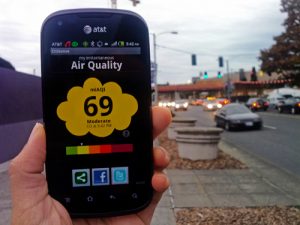
What really frustrating is that if McQuire and staff hadn’t begun his campaign to undermine the one approach that was favored by most of the entities involved, the Dallas city council would have already approved the UTD plan and we’d be on our way to building a truly independent monitoring network. Until Dallas staff objected last fall, there was a consensus about how to proceed. He’s single-handedly gutted that consensus, stifled all progress, and kept DFW way behind the air monitoring curve.
We’ll keep you up to date on how far this COG proposal gets, but Downwinders in Denton, Plano and Fort Worth should be on alert that McQuire is trying to get those cities on board with the COG approach as well. Please contact your most citizen-friendly council members and ask them not to support, what is in essence a staff coup in Dallas.
In the meantime, here’s one more question you can pose to Dallas council candidates this election season: “Do you support staff’s attempt to override the will of the council and impose a less public -friendly COG-run air monitoring network on Dallas, or the homegrown version proposed by UTD that’s already received a 7-0 vote?”
If this is going to get done right, citizens will have to do it.
Southern Sector Rising Went Eyeball to Eyeball with Dallas City Hall over Shingle Mountain. Dallas City Hall Blinked.
After a year of excuses, a determined group of women and their supporters shamed the City into finally taking action to close down the worst environmental health and justice crisis in Dallas.
When the collapse came, it came quickly.
Halfway through their Wednesday March 20th news conference giving authorities an ultimatum to shut down “Shingle Mountain” or face protests and possible civil disobedience, members of the freshly minted Southern Sector Rising Campaign for Environmental Justice learned the City of Dallas was reversing course and moving to close Blue Star’s year-old asphalt hell.
Only a week before, the official party line from City Hall was that the self-described “recycler” had all the permits it needed. Staff said critics’ description of Blue Star’s operation as an illegal dumping ground was wrong. It had “a right to be there.”
Now, on Wednesday….well, now circumstances had changed. The political circumstances that is.
Now there was a new coalition of frustrated Southern Dallas residents and Old School Icons like Peter Johnson, Luis Sepulveda and John Fullenwider staging an emotionally-charged news conference with chants of “Shame on Dallas” ringing loudly up and down the corridors of City Hall. Now there was a publicly-leaked report with incriminating evidence of official wrongdoing. Now there were swarms of cameras and reporters hanging on the every word of a middle-aged, middle-class, horse-loving DART employee who had been ignored for such a long time.
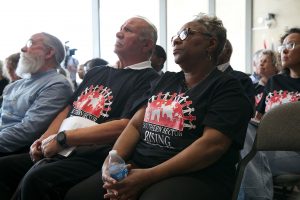
Three Generations of Dallas Environmental Justice Advocates: John Fullenwider, Luis Sepulveda and Marsha Jackson
Led by Marsha Jackson and her Choate Steet neighbors, Temeckia Durrough and Miriam Fields of the Joppa Freedman Town Association and Olinka Green from the Highland Hills Community Action Committee, with Stephanie Timko as media czarina, the Southern Sector Rising Campaign for Environmental Justice did more than just win a huge victory for an much-abused part of Dallas. It gave Southern Dallas residents a new model for effectively changing their circumstances.
An ad-hoc group that hadn’t even existed in February had the temerity to put City Hall on trial in its own lobby for Big D’s most spectacular municipal act of environmental racism in years. And it wasn’t even a fair fight.
An eye-opening state inspector’s report Downwinders sent to reporters a few days before the news conference officially documented permit violations and red flags too large to defend. Although Blue Star had promised the state in April 2018 it wouldn’t store more than 260 tons of waste at its site, it was already storing 60,000 tons in December. Blue Star was supposed to have a Fire Protection Plan. It didn’t. Blue Star was supposed to have adequate funds to close and clean up its site. It didn’t. Blue Star was supposed to randomly test incoming loads of shingles for asbestos. It didn’t.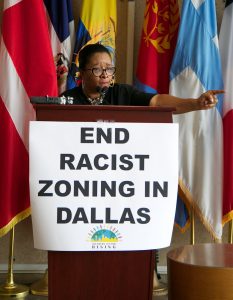
This is how bad it was: Blue Star’s mocking of the law was too much even for Gregg Abbott’s Texas Commission on Environmental Quality. Or the City of Dallas.
So long before the last speaker spoke in the Flag Room, news came that the City had pulled the Certificate of Occupancy for the largest of the two Blue Star tracts, something it had previously said wasn’t possible. Then it announced it was taking the company to court the next day to get an emergency Temporary Restraining Order to close Blue Star down.
That City staff could so shamelessly pull off such a dramatic flip flop over a matter of a few hours is testimony to both the fury fueling the Campaign, and the overwhelming evidence that Blue Star and its government enablers had allowed a full-blown illegal dump to grow… and grow…and grow. The only thing missing from the turnaround was an apology and acknowledgement to the women that had forced City Hall’s hand.
In Thursday’s hearing on the Restraining Order, the City of Dallas cited a number of missing municipal and state permits it now said Blue Star needed, including a Special Use Permit, an air quality permit, and a permit for storage in the flood plain – none of which the City had demanded when Blue Star had opened for business a year earlier. Despite the lack of these permits the City was now saying were essential, it had kept telling reporters, Council Members, and residents alike that Blue Star was a legal business right up until the time of the news conference.
It wasn’t. Ever. But it took a group of frustrated Southern Dallas residents to expose that lie.
 Of course in the hearing itself the heretofore lack of official city concern about these lacking permits was perturbing in the extreme for the attorney representing Blue Star, who said City Hall had already signed-off on its operations.
Of course in the hearing itself the heretofore lack of official city concern about these lacking permits was perturbing in the extreme for the attorney representing Blue Star, who said City Hall had already signed-off on its operations.
“The City told my client there were NO air quality problems,“ he protested to the judge. That was undoubtedly a true statement. But that conclusion was rendered before a brigade of angry residents showed up at City Hall demanding Dallas enforce the law.
Now, presto-chango, the City was emerging out of its dilapidated telephone booth with its moldy Toxic Avenger costume on and finding plenty of air quality problems, albeit in a anecdotal, non-quantifiable, way.
Because despite being “very concerned” about air pollution from Blue Star, the City of Dallas never monitored air quality from the facility before it got to court. Neither did the state. Only Downwinders at Risk, plugging-in one of our own portable PM monitors on the top of Marsha Jackson’s window unit for days at a time, captured any credible scientific evidence of air pollution harms.
Those results were released at the March 20th news conference and showed levels of Particulate Matter pollution that UNT’s Dr. Tate Barrett concluded “poses a significant health risk to the residents.”
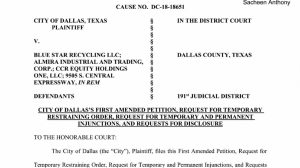
But in court, the City didn’t even mention those EPA-calibrated results.
For the first time in memory it was the regulators using only their senses to call for a crackdown – what they saw and heard and smelled at Blue Star’s site – and citizens showing up with Real Science.
Lacking any monitoring data of their own, Dallas city attorneys sounded like countless over-matched and overwhelmed residents from past TCEQ hearings, pleading with the judge to accept their word that the air pollution was so darn obvious…if not directly quantifiable because, well, no, we didn’t actually do any monitoring. We don’t know how to do that.
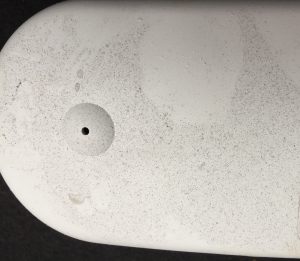
A layer of asphalt dust coated a Downwinders air quality monitor while it was recording levels of PM pollution at Marsha Jackson’s house in early March
This lack of any data to back up its air pollution claims was one of the most embarrassing parts of the hearing for the City. One wonders when James McQuire and his Office Of Environmental Quality & (Rockefeller) Sustainability’s stubborn refusal to buy its own air monitors will eventually cost the City (and its residents) in court.
But every time the City’s case looked in trouble, Blue Star’s attorney dug a deeper hole. He wanted the judge to know “shingles make really good fill” and that the spring-fed creek that ran through the company’s site was merely “a drainage ditch” and asking, after all judge, what is the true and right definition of “combustible” under Texas law?
Judge: “It means catch fire.”
Everyone but the Blue Star attorney chuckled.
After 45 minutes, Judge Gina Slaughter had heard enough and ruled in favor of the Restraining order. It took effect March 22nd and runs until Midnight on April 3rd.
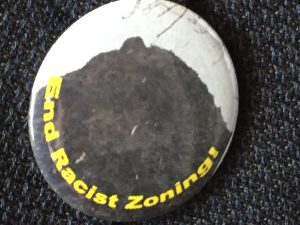 Before that happens, an 11 am Wednesday morning hearing will be held in the same courtroom to decide whether to extend the Temporary Order into a more permanent one. Word is that Blue Star was caught doing business during the last week when it wasn’t supposed to be on site at all. If true, it seems unlikely Blue Star will be granted a reprieve, despite the optimism displayed on the company’s website. “We fully expect to be open on Thursday April 4th, 2019″ it proclaims.
Before that happens, an 11 am Wednesday morning hearing will be held in the same courtroom to decide whether to extend the Temporary Order into a more permanent one. Word is that Blue Star was caught doing business during the last week when it wasn’t supposed to be on site at all. If true, it seems unlikely Blue Star will be granted a reprieve, despite the optimism displayed on the company’s website. “We fully expect to be open on Thursday April 4th, 2019″ it proclaims.
Not if Marsha Jackson, her friends in the Southern Sector Rising Campaign, and now their reluctant ally, The City of Dallas, get their way.
Take a 4 Minute Trip to “Shingle Mountain”
Sorry Ms. Jackson: The City is Failing Southern Dallas
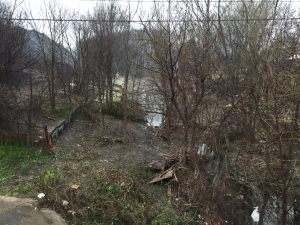
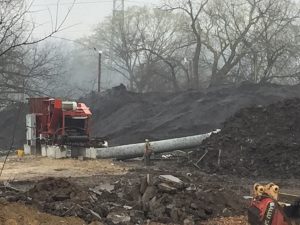
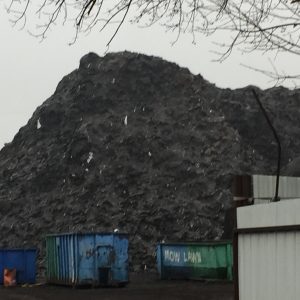
Marsha Jackson thought she’d found relief when Dallas Morning News columnist Robert Wilonsky wrote about the grotesque environmental disaster being caused by the Blue Star asphalt operation in mid-December..the first time.
After complaining almost a year to the City of Dallas, the State of Texas, and the EPA without any action taken, Ms Jackson saw Wilsonky’s column set-off a flurry of official concern about this inept and dangerous operation destroying acres of tree-covered Southern Dallas and Ms. Jackson’s home of 25 years.
That’ll happen when the city’s most read reporter informs you for the first time in passing about a situation it’s your job to already know about.
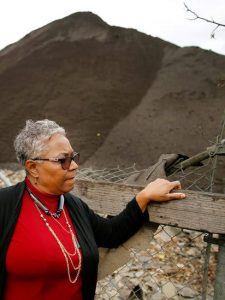 But that initial knee-jerk response left Blue Star still open for business, and without a clean-up. So Wilonsky wrote another column. Some more official action ensued. The City got a Temporary Restraining Order….that expired after a week. The authorities made Blue Star push their 4-5 story high mountains of used shingles back away from a small creek running through it’s property so the waterway would be better protected. Ms. Jackson? Not so much.
But that initial knee-jerk response left Blue Star still open for business, and without a clean-up. So Wilonsky wrote another column. Some more official action ensued. The City got a Temporary Restraining Order….that expired after a week. The authorities made Blue Star push their 4-5 story high mountains of used shingles back away from a small creek running through it’s property so the waterway would be better protected. Ms. Jackson? Not so much.
In fact, Blue Star has not been cited with even one nuisance, air pollution, or public health violation by the City of Dallas since it began building its special version of Hell a little more than a year ago. Officially, the city has shown zero concern for the human toll being taken by Blue Star’s pollution.
Last month Wilsosky wrote his third column stating what many of us feel when we see the operation in person: “This is insane.” He got Dallas City Manager T.C. Broadnax on the record saying Ms. Jackson’s plight was the result of bad zoning, the kind that allows polluters to only set-up shop south of Dallas’ historic dividing line Trinity River. But no action was taken to change that zoning and Blue Star keeps right on accepting truckloads of old shingles and keeps grinding them up in the open-air using the industrial equivalent of giant wood chippers, spewing fiberglass, plastic and maybe asbestos into Ms. Jackson’s property and neighborhood.
Blue Star keeps operating even though the City of Dallas says the business didn’t have a Certificate of Occupancy when they opened, despite evidence current city zoning doesn’t allow what they’re doing on the property they’re doing it on, and despite evidence they don’t have all the environmental paperwork they need for the despoiling taking place.
Despite his best efforts to do the job the City and State are supposed to be doing, Wilonsky’s words just haven’t been enough to stop the obscene environmental and public health problems being caused daily by Blue Star.
So maybe it’s time to do this ourselves.
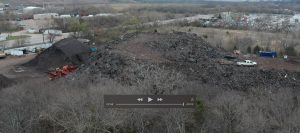
Maybe it’s time to file some lawsuits of our own, as citizens. There’s now plenty of documentation to prove the case of destruction, property rights takings, and personal and public health problems. Are there lawyers working in the public interest who could pursue these on behalf of Ms. Jackson and her neighbors? Yes there are. There are ones who can sue for regulatory relief and others who sue for “personal damages” caused by this kind of reckless disregard. These “toxic tort” attorneys would do well to target the deep pockets of the City of Dallas and the State of Texas as well as the modest holdings of Blue Star. Often the way to permanently put a stop to this kind of thing is to make the responsible parities pay such a high price that they’re never even tempted to try it again.
Maybe it’s time for us to begin amortization proceedings against Blue Star. This is the process that closed the RSR lead smelter in West Dallas in the 1980’s. A city can change the zoning for a piece of property to something that clearly does not allow the current activity to take place on that property. In order to be fair, the law allows the current users to operate until they get their investment in the property back and then they have to close-shop and move. Once you see the Blue Star property, you’ll understand that it’ll take about a day and a half for the company to get back its “investment.” In fact, because of all the violations of law and probable lawsuits, Blue Star is probably already close to being in the red.
Amortization proceedings can be initiated by the City Council OR citizens themselves. Here’s a description from the Dallas City Code using the City’s 15-member, council-appointed Board of Adjustments:
§ 51A-4.704. Nonconforming Uses And Structures.
The city council may request that the board of adjustment consider establishing a compliance date for a nonconforming use. In addition, any person who resides or owns real property in the city may request that the board consider establishing a compliance date for a nonconforming use. Upon receiving such a request, the board shall hold a public hearing to determine whether continued operation of the nonconforming use will have an adverse effect on nearby properties. If, based on the evidence presented at the public hearing, the board determines that continued operation of the use will have an adverse effect on nearby properties, it shall proceed to establish a compliance date for the nonconforming use; otherwise, it shall not.
Ms. Jackson owns her house. So maybe it’s time we help her petition the Board of Adjustments to begin kicking Blue Star out of Southern Dallas ourselves. If the Council wants to do its job and join in, that w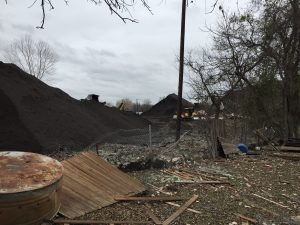 ould be great. But we don’t need them to start the ball rolling.
ould be great. But we don’t need them to start the ball rolling.
Maybe it’s time we protested. Not just on behalf of Ms. Jackson, but the ancient, racist underlying cause of this awful situation and so many more south of the Trinity River. Everyone who lives in the “Southern Sector” is a current or potential Marsha Jackson. We’ve got to begin to change the entire zoning map of the city to get rid of the kind of outrages even the City Manager acknowledges are a problem. We need to demonstrate not just against Blue Star, but for improvement across the board, for real progress on the City’s own Master Plan for South Central that aims to “de-industrialize” the area – not make it into a wasteland. We need a platform for progress that address the Southern Sector as a whole instead of continuing to play whack-a-polluter every few months at a different location.
Since August, T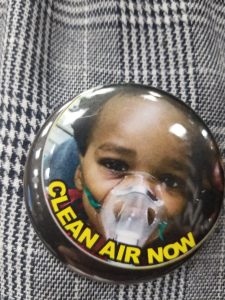 he Let Joppa Breathe Alliance has been meeting to try and draft such a platform as part of its mission. It’s been recruiting allies south and north of the river. It’s very near to making an announcement about that platform and the means it will begin to pursue it. This platform will be the first attempt to articulate specific City of Dallas environmental justice policy changes in the City’s history. It represents a tectonic shift in responding to age-old discrimination that’s still leaving a huge dusty coal-like legacy in Southern Dallas. We’re tired of playing defense. Its time we set the agenda.
he Let Joppa Breathe Alliance has been meeting to try and draft such a platform as part of its mission. It’s been recruiting allies south and north of the river. It’s very near to making an announcement about that platform and the means it will begin to pursue it. This platform will be the first attempt to articulate specific City of Dallas environmental justice policy changes in the City’s history. It represents a tectonic shift in responding to age-old discrimination that’s still leaving a huge dusty coal-like legacy in Southern Dallas. We’re tired of playing defense. Its time we set the agenda.
Dallas City Hall has failed Ms. Jackson and her neighbors. It’s failed Joppa. It’s failed Cadillac Heights, and Highland Hills and Fruitdale, and West Dallas. Over and over again. To win progress, something more must be done. When the call comes for that something more, how will you respond?
San Antonio and Houston Move Forward with New Regional Air Monitoring Networks. Dallas Doesn’t.
Last time we reported on the prospects of a new regional air monitoring network the idea received a 7-0 vote from a Dallas City Council Committee on September 24th but was delayed by staff request from going to the council until December 12th.
There was conjecture at the time that the delay was an excuse to actually find ways to kill the idea and if that was the goal, it’s 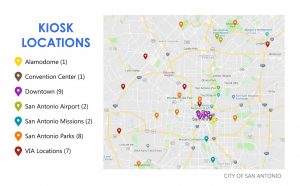 succeeding so far. After a year of hearing no objections from Dallas staff to the idea of establishing an independent entity among local governments to run the network, all of a sudden City Hall took great offense at the very idea.
succeeding so far. After a year of hearing no objections from Dallas staff to the idea of establishing an independent entity among local governments to run the network, all of a sudden City Hall took great offense at the very idea.
Over the past month Dallas County has been in talks with Dallas city staff to find another way to implement the network. Government-sponsored non-profits are being studied. Downwinders continues to advocate a entity that assures public participation in decision-making and robust enough to maintain a growing network of different monitors in different cities. Without more progress being made quickly it’s hard to figure out how the proposal makes it before the Council by December 12th.
While Dallas delays, both San Antonio and Houston are proceeding with their own new air monitoring networks.
In San Antonio, it’s through a deal with IKE Smart City that will trade ads on kiosks for 30 free kiosks that will give directions, recommend local eateries, provide free WiFi in a 150-foot radius, and take Particulate Matter pollution readings. The project is funded entirely by IKE Smart City. Unlike DFW, San Antonio hasn’t even violated the Clean Air Act and it already has more monitors than the Metromess.
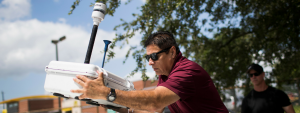 Beginning in December 2017 the Environmental Defense Fund working with the Houston Health Department and the university of California Berkley placed 20 air quality sensors across the city. Some were placed in known pollution hots spots like the predominantly black neighborhood of Pleasantville on Houston’s east side, where pollution from warehouses, metal recyclers, salvage yards, an Anheuser-Busch’s Houston brewery and an interstate often make it hard to breathe.
Beginning in December 2017 the Environmental Defense Fund working with the Houston Health Department and the university of California Berkley placed 20 air quality sensors across the city. Some were placed in known pollution hots spots like the predominantly black neighborhood of Pleasantville on Houston’s east side, where pollution from warehouses, metal recyclers, salvage yards, an Anheuser-Busch’s Houston brewery and an interstate often make it hard to breathe.
“If somebody asked me how many fixed site monitors we need, I would say there are never enough,” said Loren Raun, chief environmental officer with the Houston Health Department, which has since received funding to purchase similar instruments from Entanglement Technologies.
One can’t imagine anyone on Dallas city staff saying the same thing. In fact on more than one occasion staff has said they’re just fine with the nine monitors the Texas Nature Conservancy is due to be installing at Dallas schools this year and they’re in no rush to add any more.

Just another day in Joppa
And one especially can’t imagine Dallas city staff going along with putting monitors in known Dallas pollution hot spots like Joppa or West Dallas. Despite the recent controversy over the proposed two new batch plants rejected by the City Council in March – in part because of portable monitor readings from Downwinders showing already high levels – staff said recently they still have no plans to purchase their own air sensors.
This kind of official rebuff to high tech low cost sensors gives lie to the city staff’s rhetoric about “Smart Cities”as well as its sudden concern over asthmatic black kids. If staff really cared about them, why wouldn’t it buy air monitors it could use in field to investigate complaints in their neighborhoods instead of just guessing the air quality there, or using an EPA monitor nine miles away to claim everything was just fine? Why wouldn’t the City be rushing to install monitors in hots spots like Joppa? Because statements made in pursuit of Rockefeller Foundation grants do not carry the force of law, or even as it turns out, curiosity.
End of Year Report: DFW Smog Goes Up While Going Down; PM is Worst Since ’03
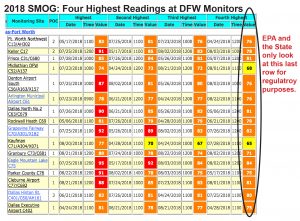
Only in the nonsensical world of EPA air quality regulation could the official regional average for DFW smog actually decrease despite the worst levels of DFW Ozone pollution in five years.
In 2018 a quarter of all North Texas official monitor sites recorded smog levels in the 90-95 ppb range for more than an hour. 2018 was the first time in two years that any DFW monitors have had 8-hour averages of 80 ppb or above, and the first time since 2013 since there been at least six. In fact, this year’s total number of 80-or-above monitors is almost equal to the total number from the last five years combined.
Nevertheless, the regional average for smog pollution that determines government action actually went down from 81 to 76 parts per billion.
How does that happen? Not without a lot of numerical manipulation. EPA’s formula for smog pollution classification is a two part affair. First EPA only counts the highest 4th highest annual reading from each monitor in DFW. That means every monitor gets three “Mulligans” or “do-overs” before the results are eligible for regulatory use. Then EPA combines the last three year’s worth of those highest 4th highest readings to produce a rolling average. So that 2018 average is actually the results of the highest 4th highest reading from 2016, 2017, and 2018.
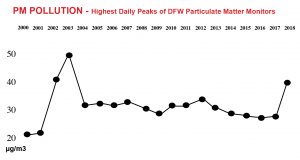
High readings from the summer of 2015 are rolling out of that three-year rolling average, while lower readings in ’16 and ’17 remain. While this year’s smog levels were higher, but not so extraordinarily high as to be able to counter the lower numbers making up the rest of the average.
But our smog was bad enough last year and this to once again make sure DFW is in “non-attainment” of the clean Air Act for the pollutant. For the umpteenth time in a row, we missed a deadline for meeting a Clean Air Act smog standard – this time it’s the 2008 75 ppb standard. If EPA follows its own protocol, that means DFW will be go from being “moderately” out of compliance to being in “Serious” non-compliance.
And please remember all of these numbers are based on only 20 smog monitors, half of which are located well-outside the DFW urban core, and none of which are located in Wise County, where Downwinders is doing the job of monitoring ozone pollution that the State and EPA refuse to do.
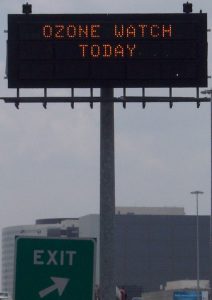 What are the consequences of this continuing violation of the Clean Air Act that imperils public health? Nada probably. At least while the Trump Administration holds office. In the past such classifications would have triggered a process leading up to some kind of official plan of action that, at least rhetorically, is aimed at correcting the 30-year old problem. But no one expects the State of Texas, or now the EPA, to take that responsibility seriously.
What are the consequences of this continuing violation of the Clean Air Act that imperils public health? Nada probably. At least while the Trump Administration holds office. In the past such classifications would have triggered a process leading up to some kind of official plan of action that, at least rhetorically, is aimed at correcting the 30-year old problem. But no one expects the State of Texas, or now the EPA, to take that responsibility seriously.
What you can expect is some official TCEQ spin about how it’s been successful in bringing down smog pollution levels. In fact, it was the wettest September on record that brought an abrupt end to what was shaping up to be an even worse smog year than it already was at the end of August. Historically, September is when DFW sees some of its worst bad air days. But not this year.
Accompanying the rise in smog pollution in 2018 was also a dramatic rise in the regional numbers for Particulate Matter (PM) pollution – the highest North Texas has seen since 2003.
After a long spell of annual peaks of between 24 and 28 migrograms per cubic meter of air, the 2018 average for highest daily readings among all sites has risen dramatically as of this month – to almost 40 µg/m3
Before this year, they’d only been four daily peaks above 40 µg/m3 over the last 15 years. In 2018 four out of 6 PM monitoring sties had registered daily readings averaging between 41 an 43 ppb as of October.
The EPA annual standard for PM pollution is 12 µg/m3. The 24 hour standard is 35 µg/m3.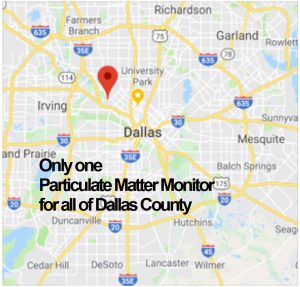
As with smog, these readings are coming from a very small pool of monitors – in this case just six PM monitors scattered over an area only slightly smaller than Rhode Island.
Some of this might be blamed on the drought we we experiencing during the summer and increased dust circulation, but comparing it to 2011 when similar if not worse conditions were in play shows no similar bump then. Fewer coal plants blowing their plumes into DFW this year might lead you to think we were even due for a drop. Instead it’s as if someone turned the key on a couple more. There’s no obvious reason why PM levels would have jumped so much in a single year.
What’s clear is that local governments are the last refuge for effective and new air pollution control measures. Until political leadership changes in Austin and/or Washington, there’s no expectation of any relief. In fact, every day sees new proposals from the State or EPA that will actually increase smog and PM pollution in DFW. This is why local city and county elections are just as important as state and national ones.
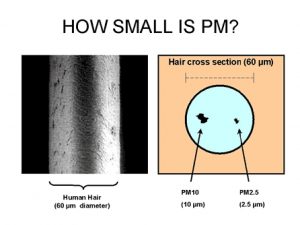 We’ll have to wait until the end of 2019 to see if this rise in pollution averages is a trend or blip, but there’s no question that smog and PM are taking their toll on public health in DFW. Study after study shows harms at levels of exposure well below these annual and daily averages that determine EPA regulations. In the real world, your lungs, heart, brain and immune system don’t seem to be able to distinguish between “safe” and “unsafe” levels of poison as defined by the government.
We’ll have to wait until the end of 2019 to see if this rise in pollution averages is a trend or blip, but there’s no question that smog and PM are taking their toll on public health in DFW. Study after study shows harms at levels of exposure well below these annual and daily averages that determine EPA regulations. In the real world, your lungs, heart, brain and immune system don’t seem to be able to distinguish between “safe” and “unsafe” levels of poison as defined by the government.

